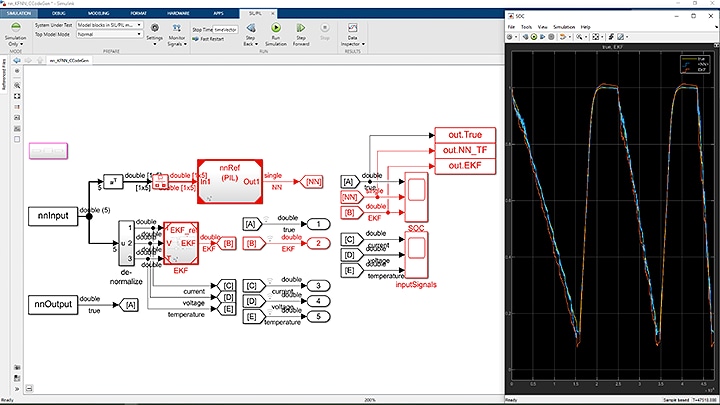
- Smarter World Blog
- Model-Based Design Helps Power Embedded Software Development for BMS
Model-Based Design Helps Power Embedded Software Development for BMS

Estimating battery state of charge (SoC) is difficult and complex because of the non-linear character of the batteries and the internal environment assessments. Neural networks and NXP’s model-based design toolbox (MBDT) help simplify the development of a battery SoC estimation algorithm.
Modern battery management systems (BMS) ensure cell packs' safe and efficient operation in various solutions within electric vehicles, power supplies, smartphones, MP3 players and most battery-driven equipment. Calculating the battery state of charge (SoC) is one of the most critical roles of BMS, an estimation the system assesses –like the battery percentage displayed in a phone. An accurate estimation of SOC protects the battery, prevents discharge/overcharge and improves its life; it also lets the solution perform control strategies for energy-saving.
Traditionally, an engineer would need to build a very accurate battery model to get reasonable estimations, but that is often hard to characterize. This problem fueled the search for an alternative in which artificial intelligence brought its contributions. Battery power management developers started to use adaptive systems, like neural networks (rather simple ones), to create data-driven models of the cell and use them to get a very accurate SoC estimation by evaluating the history of voltage, current and ambient temperature.
Model-Based to the Rescue
Estimating battery SoC is challenging and complex because the cell configuration is non-linear (making it hard to model it correctly), and the internal environment is hard to assess (comparing laboratory versus real-world conditions) –thus raising the instability of the battery. Model-based algorithms are the most investigated techniques for estimating SoC in lithium-ion (Li-ion) batteries. Engineers found in model-based a change in the paradigm to design and deploy robust solutions. Model-based design (MBD) implies putting together graphical elements that implement specific functionalities to design an application. Building a solution using MBD is relatively simple. The diagram for the application logic is transcribed into a model-based software environment to implement the control algorithm.

Developing applications in those MBD environments help to:
- Simulate: verifying algorithms before interacting with hardware saves time and money
- Generate code automatically: avoiding many hand-written code issues while increasing design stability/error robustness
- Reuse: the functionality can be reused in any other model once the model is ready and thoroughly tested
- Focus on the application itself: looking at a diagram representing the application (algorithms, logic...) instead of studying numerous code lines, searching for the embedded comments to understand their meaning –not being entangled in minor details but application-centric/model-centric
Using the MBD viewpoint helps compensate for the increased complexity of modern applications. It also takes advantage of the software abstraction layers commonly used for embedded designs development (hardware optimized device drivers, plus middleware and libraries that implement specific functionalities) while enhancing drivers' code optimization and reusability.
Compared to a typical development workflow, which implies writing the (C code) application algorithm and integrating it with specific hardware function calls, code is automatically generated from the model in the MBD development. Furthermore, it can work together with necessary hardware-specific software, transforming the programming into block parameters configuration.

Also, we provide the S32 Design Studio IDE where programming is executed with build, debug and configuration embedded tools (allowing setting and initializing drivers, middleware, and libraries used inside the design in a graphical manner). Besides the classical debugger options, we also offer FreeMASTER, our data visualization tool enabling real-time application debugging for validating the system behavior for imposed performances. FreeMASTER features options like writing and reading variables, memory locations, and monitoring desired signals on the embedded target.
Model-in-the-Loop (MiL)
MBD applications can be verified and validated inside the Simulink ecosystem using its simulation functionalities, while test and verification can be performed starting from the requirements definition phase. Simple models can be designed and simulated to validate the algorithm's high-level behavior. After that, certain functionalities and subsystems of the design can be modeled, tested and simulated independently at a more detailed level; also, results can be displayed and analyzed — all in a PC-enabled environment to check the feasibility of the ideas.
Software-in-the-Loop (SiL)
Code can be generated and executed on the host PC for the design after the simulation results are satisfactory for the imposed system behavior. SiL provides an idea of how the implemented logic will be transcribed into code, creating the context for code optimization and efficiency improvements before the application runs on the target.
Processor-in-the-Loop (PiL)
Various models or parts of the application can be directly tested on the target. PiL provides relevant information related to the capability of the chosen hardware to run the developed application logic. Engineers can compare the results obtained in all of these phases, allowing testing the design at every development step.
MCU Final Application
MBDT simplifies building the application from the previously tested and validated modules and deploying it as a final solution. Engineers can use MBDT at any stage to take advantage of its functionalities: mathematical functions simulations, code generation and MCUs drivers configuration and control.
On top of the robust MBDT capabilities and features, our MBDT team made available a broad online engineering support community packed with code examples, forum answers, quick start guides, 101 tutorials and more resources to get started designing, verifying and deploying embedded applications: MBDT community . They also developed a series of webinars, from beginner to advanced level, showcasing motor control (guiding how to build a PMSM or BLDC application from scratch, walking step by step through the development process) or battery management systems application (including a Deploying a Deep Learning-based State-of-Charge Estimation Algorithm to NXP S32K3 MCUs training with MathWorks)
Using model-based design toolbox (MBDT) helps power embedded software development for battery management systems (BMS) by simplifying the battery state of charge (SoC) estimation algorithm development. MBDT takes advantage of the software abstraction layers to automatically generate code from the SoC algorithm model, easily transforming the programming into block parameters configuration.


Authors

Irina Costachescu
Irina is a Software Engineer with the Model-Based Design Toolbox (MBDT) team. Irina contributes to all MBDT development phases, from framework design to peripherals support. Irina also creates related webinars, videos, and training sessions for MBDT. Irina holds a Bachelor's Degree in Automatic Control and Systems Engineering and a Master's Degree in Complex Systems, both from the Polytechnical University of Bucharest.

Razvan Chivu
Razvan has worked in the semiconductor industry, focused on automotive tools. He is the current engineering manager for the Model-Based Design Toolbox (MBDT) team in Bucharest, Romania. Razvan holds a Bachelor's Degree in Computer Science and a Master of Engineering, both from the Polytechnical University of Bucharest.


